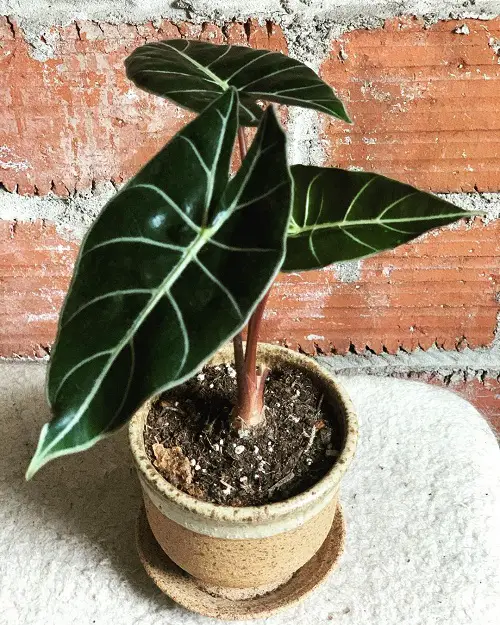Read in detail about Alocasia Dragon Tooth care in this comprehensive guide to promote growth for these striking indoor plants.

Learn how to care for Alocasia Dragon Tooth plants with ease as you explore the essential steps to keep these captivating indoor beauties thriving.
Alocasia Dragon Tooth Information

Alocasia Dragon Tooth is also popular as Alocasia Longiloba ‘Dragon Scale.’ It is a tropical plant famous for its unique leaf texture and pattern.
It features large, heart-like leaves with a prominent texture resembling dragon scales. The leaves are dark green to black-green and adorned with contrasting silver veins. The leaf edges are serrated or toothed, hence its common name, “Dragon Tooth.”
This Alocasia variety typically grows to a moderate size, with mature plants reaching a height of around 1 to 2 feet (30 to 60 cm) and a spread of 1 to 2 feet (30 to 60 cm).
Botanical Name: Alocasia longiloba ‘Dragon’s Tooth’
Propagating Alocasia Dragon Tooth
From Division:
Remove the plant from its pot and gently separate the rhizomes. Ensure each division has a healthy root system and at least one stem. Use a clean, sharp knife or shears to make clean cuts. Plant each division into a separate pot filled with well-draining soil.
Water the divisions lightly and place them in a warm, humid location with bright, indirect light.
Rhizome Cuttings
Select a healthy rhizome with at least one stem and some roots. Cut a section of the rhizome a few inches in length. Make sure each cutting has at least one node. Plant the cutting horizontally in well-draining soil. Bury the node below the soil surface.
Keep the soil slightly moist and place the pot in a warm, humid environment with bright, indirect light.
Requirements for Growing Alocasia Dragon Tooth

Light
Alocasia Dragon Tooth plants grow well in ample light, preferably bright and indirect, for approximately six hours daily. While they can tolerate lower light conditions, optimal growth and vitality are achieved in brighter settings.
Soil
Use well-draining soil, a simple and effective soil recipe for this plant, which consists of equal parts potting soil, peat, and perlite.
Avoid using heavy or compacted soil, as it retains too much moisture.
Water
Alocasia Dragon Tooth plants have moderate water needs, preferring not to dry out entirely but also disliking standing water. Overwatering can lead to their decline. It’s best to water them when about 50-75% of the soil has dried out. If uncertain, it’s safer to hold off on watering rather than risk overdoing it.
Temperature and Humidity
Optimal temperatures for Alocasia range between 60 and 80 degrees Fahrenheit, and they favor warmer climates for their growth and health.
Alocasia plants are native to tropical and subtropical areas and thrive in high humidity conditions. To promote their well-being, use a humidifier or a pebble tray with water.
Alocasia Dragon Tooth Care

Fertilizer
Use a balanced, water-soluble houseplant fertilizer, such as a 10-10-10 or 20-20-20 formula. Dilute the fertilizer according to the manufacturer’s instructions, typically at a rate of ¼ to ½ strength.
Apply every four to six weeks during the growing season, which is usually from spring to summer. Reduce or stop fertilization during the winter months.
Pests and Diseases
Alocasia Dragon Tooth is susceptible to spider mites, aphids, and mealybugs. Treat the plant with a neem oil solution to keep these pesky pests away.
Excessive watering is often the main cause of plant diseases. Although the Alocasia Dragon Tooth is not highly susceptible to diseases, it can still occur due to watering practices. Bacterial and fungal infections thrive in moist conditions, so it is important to avoid excess soil or leaf moisture. Overwatering can also lead to root rot.
Toxicity
Alocasia Dragon Tooth contains calcium oxalate crystals, which can be toxic to humans and pets if ingested. If these crystals come into contact with the mouth, throat, or gastrointestinal tract, they can cause irritation and discomfort.


